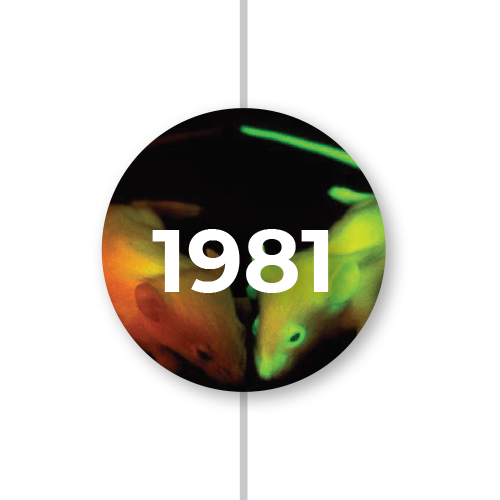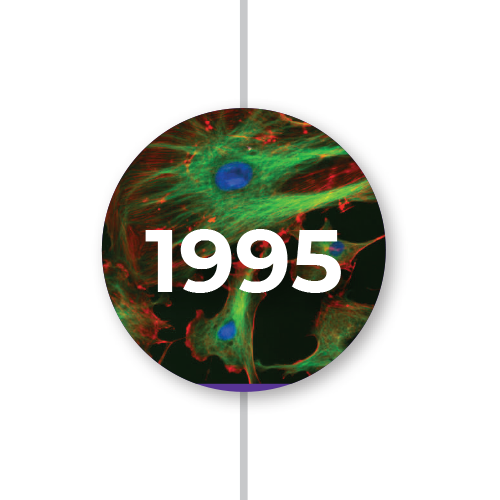Plasmid’s Rise to Prominence
Over the past 40 years, plasmid DNA has become a major cornerstone of modern research. From understanding genes at their most basic level to potential therapies for human disease, plasmid DNA plays a pivotal role in today’s life sciences. Plasmids are naturally occurring extrachromosomal DNA that are most commonly found in bacteria. Much like a Tweet gone viral, plasmids replicate independently of chromosomes and often contain genes that benefit the host for survival, such as antibiotic resistance.
Plasmid DNA was first isolated and purified from bacteria in 1967, about the same time as Tie-dye and Bell-bottoms were in fashion. Scientists have been artificially engineering plasmid DNA in order to unlock the secrets of life ever since. With the characterization of restriction enzymes in the 1960s, the development of bacteria transformation and cloning techniques in the 1970s, and the invention of PCR by Kary Mullis in 1983, plasmid DNA has enjoyed a Rolling Stones-esque career arc and staying power, with seemingly limitless utility.
Plasmid Over Time

Plasmid DNA is first used as a way to transform bacteria into manufacturing plants.
In 1978, researchers paid about 63 cents a gallon for gas, listened to music on an 8 Track Player, and managed to clone human insulin in E. coli, providing a cheap source of insulin that avoids an immune response in patients.

Plasmid DNA expresses foreign genes in a mammalian cells
Further adjustments to expression vectors and transfection techniques made performing recombinant gene studies in mammalian cells as easy as toast.

Plasmid DNA used to generate the first transgenic animal
Researchers Richard Palmiter and Ralph Brinster generated mice expressing thymidine kinase from herpes simplex virus by injecting recombinant plasmid DNA into fertilized mouse embryos. Genomic integration of plasmid DNA ushered in the development of transgenic animals and stable cell lines, adding insane goodies to the researcher's toolbox like knock-outs, knock-ins, overexpression, disease models, conditional mutants, fluorescently labeled proteins, and targeted integration that are commonplace today. Who knows? Maybe one day plasmid DNA will make pigs fly.

Plasmid DNA used in genetically modified crops
With some help from the soil bacterium Agrobacterium tumefaciens, scientists successfully integrated recombinant plasmid DNA into plant chromosomes. Various crops including corn, soybean, sugar beets, potatoes, tomatoes, squash, and rice have been genetically modified in order to increase growth rate, shelf life, durability, nutritional value, and resistance to disease. Unfortunately, no progress has been made in making kale taste better and don't even get us started on chard.

Plasmid DNA sheds light on gene promoters
Researchers developed a quick method for monitoring promoter activity in a mammalian cells by fusing the firefly luciferase gene to cloned promoter sequences in plasmid DNA.

Plasmid DNA first used in gene therapy treatments
Plasmid DNA injected into the muscle tissue successfully transfected cells in vivo, thus offering a direct route to a potential therapeutic result.
The main limitation of the injectable plasmid DNA approach, aside from the scary long needle, is poor gene transfer efficiency. But, there are several benefits when compared to recombinant viruses, namely: large DNA packaging capacity, high stability at room temperature, low risk for oncogenesis and immunogenicity, simple construction, and easy generation of large quantities.
Clinical trials are under way to evaluate plasmid mediated gene therapy for cardiovascular, neurological, cancer, ocular, inflammatory, and infectious diseases.

Plasmid DNA first used in vaccinations
Plasmid DNA was found to induce an immune response faster than ragweed triggers a runny nose when injected into the skin or muscle of mice, which made for a convenient method to manufacture vaccines.
Unlike traditional vaccines, DNA vaccines stimulate both humoral immunity (antibodies) and cell-mediated immunity (T-cells). Clinical trials are already evaluating DNA based vaccination in humans for a virtual Top-5 of insidious diseases like: HIV, Cancer, Influenza, Malaria, and HPV.

Plasmid DNA used to visualize protein expression in cells
Scientists fused fluorescent markers to proteins in order to light up their target protein like the Las Vegas Strip.

Plasmid DNA can turn gene expression off, just like a power switch
Plasmid DNA engineered to synthesize small RNAs inside the cell provided a unique way to assess gene function by suppressing gene expression in mammalian cells using RNA-mediated interference (RNAi). By using plasmid DNA to generate RNA directly inside the cell, researchers overcame the limitations of traditional RNA-mediated interference techniques.

Plasmid DNA makes targeted genomic integration in rodent embryos possible
Researchers revolutionized conventional gene targeting techniques used to generate transgenic animals by coinjecting single cell embryos with sequence-specific zinc-finger nucleases and plasmid DNA homologous to the ends flanking the cut site in the genomic DNA.

Programmable and efficient gene targeting in vivo using plasmid DNA
By transfecting mammalian cells with plasmid DNA expressing Cas9 and single guided RNA, researchers used prokaryotic RNA-based adaptive immune system CRISPR/Cas to quickly and precisely engineer mammalian genomes inside living cells.
ZymoPURE™: The Fastest Method for Purifying High Yields of Ultra-Pure Plasmid DNA

Fastest
Simple 16-minute Midi/Maxi preps

Highest Yield
Up to 25 mg from a spin-column

Ultra-Pure
Endotoxin-Free & Transfection Ready


